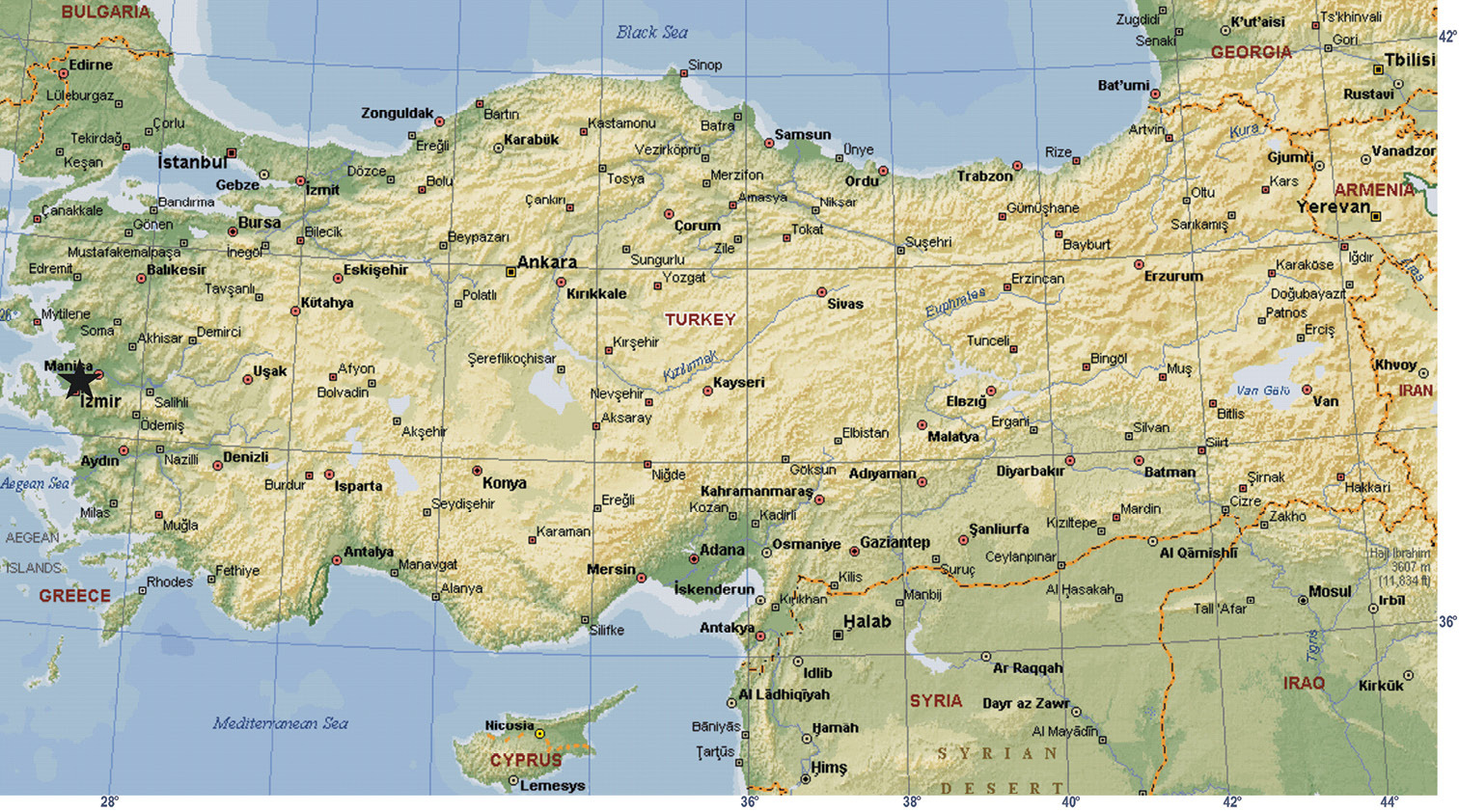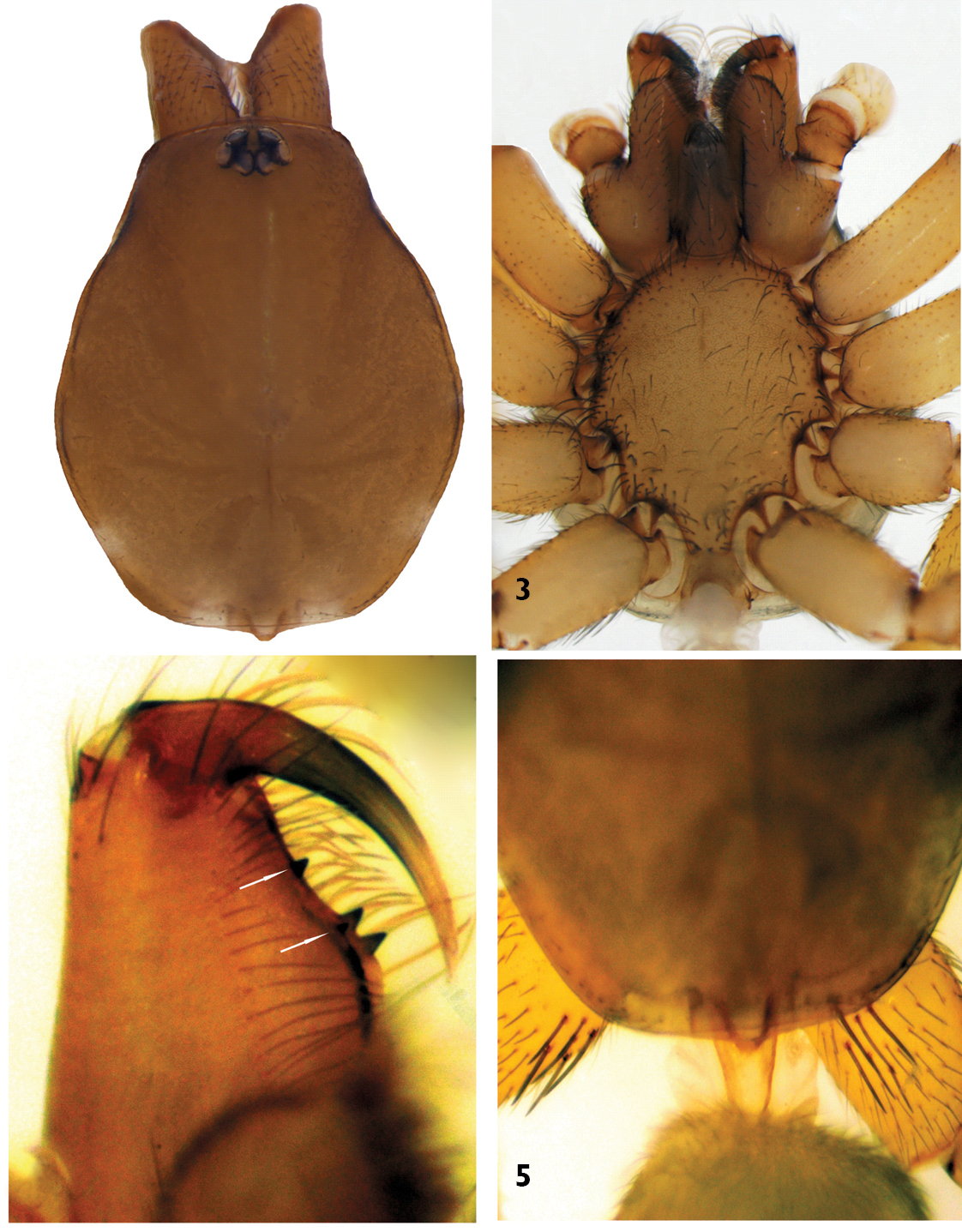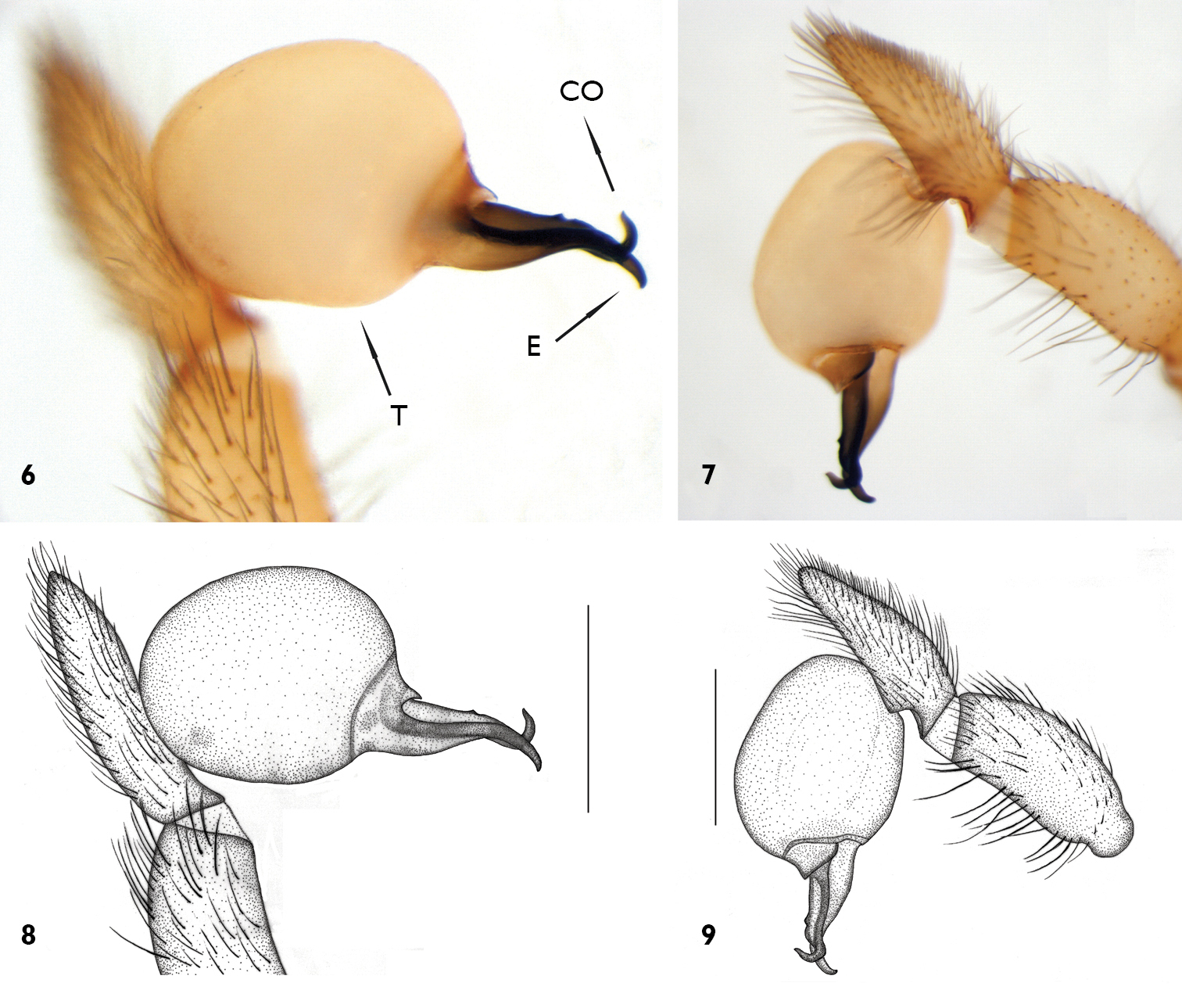Zookeys 59: 39–45, doi: 10.3897/zookeys.59.483
A new species of Harpactea (Araneae, Dysderidae) from Aegean region of Turkey
Kadir Boğaç Kunt1,†, Recep Sulhi Özkütük2,‡, Rahşen S. Kaya3,§
1 Turkish Arachnological Society. Eserköy Sitesi 9/A Blok No:7 TR-06530 Ümitköy, Ankara, Turkey
2 Department of Biology, Faculty of Science, Anadolu University, TR- 26470 Eskişehir, Turkey
3 Department of Biology, Faculty of Arts and Sciences, Uludağ University, TR-16059, Bursa, Turkey
Abstract
A new species of the spider genus Harpactea Bristowe, 1939 is described from the Aegean region of Turkey – Harpactea erseni sp. n.
(males only). Detailed morphological description and illustrations of
the new species are provided. The relationships of the new species are
discussed.
KeywordsDysderidae, Harpactea, new species, Turkey
Introduction
The family Dysderidae C. L. Koch, 1837 is represented by 504 species in 24 genera worldwide (Platnick 2010). Harpactea Bristowe, 1939 is a species rich genus with 155 described taxa and is particularly diverse in the Mediterranean region (Platnick 2010).
Most of the species appear to be endemics with restricted distributions
in the Mediterranean, with only a few found in adjacent areas (Řezáč 2008). So far, 19 species of Harpactea have been recorded from Turkey, 17 of which are endemic to the country (Bayram et al. 2010).
However, most of these species are still poorly known and have not
been revised since their original descriptions. Nevertheless, the
diversity of Harpactea
in Turkey is high in comparison to well-studied adjacent countries such
as Azerbaijan (14 species), Bulgaria (19 species), Georgia (10
species) and Greece (24 species) (Bosmans and Chatzaki 2005; Otto and Dietzold 2006; Lazarov 2010; Lazarov and Naumova 2010; Van Keer and Bosmans 2010).
During our surveys of the Turkish spider fauna we found one undescribed species of Harpactea in the Aegean region, which is described herein.
Material and methods
Three males were collected from İzmir province in the Aegean region of Turkey (Fig. 1)
using a hand aspirator. The specimens were preserved in 70% ethanol and
deposited in the Museum of the Turkish Arachnological Society. Digital
images of the pedipalp were taken with a Leica DFC290 digital camera
attached to a Leica M205 C stereomicroscope and 5–15 photographs were
taken in different focal planes and combined. All measurements are in
mm. Terminology for the body measurements and copulatory organ
structures were taken from Chatzaki and Arnedo (2006). The following abbreviations were used in the text: AL, abdominal length; CL, carapace length; CWmax, maximum carapace width; CWmin, minimum carapace width; AME, anterior median eyes; PLE, posterior lateral eyes; PME, posterior median eyes; AMEd, diameter of anterior median eyes; PLEd, diameter of posterior lateral eyes; PMEd, diameter of posterior median eyes; ChF, length of cheliceral fang; ChG, length of cheliceral groove; ChL, total length of chelicera (lateral external view); Ta, tarsus; Me, metatarsus, Ti, tibia; Pa, patella; Fe, femur; Tr, trochanter; C, coxa; D, dorsal; Pl, prolateral; Rl, retrolateral; V, ventral; CO, conductor; E, embolus; T, tegulum; MTAS, Museum of the Turkish Arachnological Society, Ankara, Turkey.
Figure 1.
Type locality of Harpactea erseni sp. n (*).
Taxonomy
Harpactea Bristowe, 1939
Material examined:
Holotype ♂ (MTAS) İzmir Province, Yamanlar Mountain, Karagöl [38°33'26.00N; 27°13'11.00E], 28. XI. 2008, under stones, leg. K.B.Kunt. Paratypes: 2 ♂ (MTAS) same data as holotype.
Derivatio nominis:
The new species is dedicated to “Ersen Aydın
Yağmur” who made a great contribution to our knowledge of Turkish
scorpions and who is a good friend of the authors.
Diagnosis:
Harpactea erseni sp. n. differs from other Turkish Harpactea species (see Nosek 1905; Alicata 1974; Brignoli 1978a-b; Brignoli 1979; Bayram et al. 2009) in the structure of the pedipalp of the male. However, the palpal structures of Harpactea erseni sp. n. are close to Harpactea strandjica Dimitrov, 1997 and Harpactea terveli Lazarov, 2009 described from Bulgaria (see Lazarov 2009). The new species can be distinguished from Harpactea terveli by the different shape of the embolus and conductor; and from Harpactea strandjica by having a thinner, curved embolus without a bifurcated tip.
Comments:
Harpactea is one of the most endemic and speciose dysderid genera in Turkey, with 17 endemics (Bayram et al. 2010).
Most of the endemic species have restricted distributions and occur at
high elevations, such as the mountain ranges of the Mediterranean, and
the north and central Anatolian regions. This distribution pattern
presumably results from the combination of topography, proximate
biogeographical subregions, the high number of different biotopes and
the climate of Anatolia, all of which play a special role in
speciation. In short, the Anatolian Harpactea
fauna is characterized by a high level of local endemism, and by
limited co-occurrence of species in the adjacent zoogeographical
regions. However, one question can be raised regarding the newly
described species: is the male a specimen of a previously described
species known only from the female (presumably from Turkey or
neighboring countries)? According to our morphometric data, our samples
are larger than all previously described Harpactea species from Turkey (see Brignoli 1978a–b), supporting our conclusion that it is in fact a new species, rather than the male of a previously described female.
Measurements (holotype):
AL 4.05; CL 3.45; CWmax 2.25; CWmin 1.35; AMEd 0.15; PLEd 0.13; PMEd 0.10; ChF 0.76; ChG 0.34; ChL 1.35 mm. Leg measurements are given in Table 1.
Table 1.
Leg measurements of Harpactea erseni sp. n.
| Legs |
I |
II |
III |
IV |
|---|
| C |
1.65 |
1.28 |
0.88 |
1.20 |
| Tr |
0.52 |
0.34 |
0.34 |
0.37 |
| Fe |
3.15 |
2.63 |
2.45 |
3.00 |
| Pa |
1.20 |
1.76 |
1.23 |
1.50 |
| Ti |
2.55 |
2.46 |
2.02 |
3.38 |
| Me |
2.63 |
2.25 |
2.15 |
2.63 |
| Ta |
0.80 |
0.83 |
0.83 |
0.84 |
| Total |
12.50 |
11.55 |
9.90 |
12.92 |
Description:
Carapace light brown, with smooth surface and distinct fovea. AME, PLE and PME closely grouped; AME separated (Fig. 2). Sternum, labium, gnathocoxae and chelicerae yellowish-brown. Sternum with long, thin hairs near the margin (Fig. 3).
Cheliceral groove with four teeth: retromargin with two teeth,
including a tiny one at the base of the groove; promargin with two
strong teeth of equal size close to each other. Top of the labium and
gnathocoxae with short, strong hairs, sparsely distributed (Fig. 4).
Abdomen greyish-light brown, with short, thin blackish hairs over the
entire surface. Legs yellowish-light brown with sparse blackish setae.
Leg IV > Leg I > Leg II > Leg III. Tarsi with three claws.
Tarsi III and IV with fine scopulae. Legs III and IV with fine
metatarsal scopulae covering slightly less than the distal half of the
segment (ventral surface only). Dorsal part of coxae III and IV with 2–6
spines (Fig. 5). Details of leg spination are given in Table 2.
Palpal organ with globular bulb and curved,
black embolus tapering towards the tip. Conductor same colour as embolus
and hook-shaped at the tip and with a tuberculum on the mid-part (Figs 6–9). Female unknown.
Figures 2–5.
Harpactea erseni sp. n. 2 Carapace 3 Sternum 4 Right chelicer, ventral view 5 Coxae IV, dorsal view.
Table 2.
Leg spination of Harpactea erseni sp. n.
| Legs |
I |
II |
III |
IV |
|---|
| C |
0 |
0 |
2-3 D |
5-6 D |
| Tr |
0 |
0 |
0 |
0 |
| Fe |
2 Pl |
1, 1 Pl |
2, 2, 2 D |
1, 2, 2 D, 2-4 Rl |
| Pa |
0 |
0 |
1 D |
1 Rl |
| Ti |
0 |
0 |
6 Pl, 1 Rl, 2, 1, 2 V |
1, 1, 1 Pl, 1, 1 Rl, 5-6 V |
| Me |
0 |
0 |
6 Pl, 1, 1 Pl, 5-6 V |
3 Pl, 4 Rl, 3-5 V |
| Ta |
0 |
0 |
0 |
0 |
Figures 6–9.
Harpactea erseni sp. n., general appearance of right bulb 6–8 Prolateral view 7–9 Retrolateral view CO Conductor E Embolus T Tegulum (Scale lines: 0.5 mm)
According to the classification of Deeleman-Reinhold (1993), Harpactea erseni sp. n. belongs in the rubicunda
(D) species group which is characterized by having a globular palpal
body, a massive embolus and conductor and patellae-coxae with spines.
Up until now 20 (including the new species) Harpactea
species have been reported from Turkey. Although the diversity of this
genus in Turkey is comparatively high, it can be expected that the
actual diversity will be even higher because many regions with
favourable habitats for Harpactea remain to be studied in Turkey. Therefore, we expect that more species will be found in the future.
Acknowledgements
We are very grateful to Dr. Christo Deltshev and Dr.
Stoyan Lazarov (Sofia; Bulgaria) for their valuable comments regarding
the new species. The English of the final draft was kindly checked by
Dr. David Penney (Manchester; UK).
ReferencesAlicata P(1974) Su una nuova specie di
Harpactea (Araneae, Dysderidae) della Turchia. Animalia 1:69-72.
Bayram A, Kunt KB, Danışman T(2010) The
checklist of the spiders of Turkey, Version 10.1.0. Ankara: Turkish
Arachnological Society.
http://www.spidersofturkey.com [accessed 17.V.2010]
Brignoli PM(1978a) Ragni di Turchia IV.
Leptonetidae, Dysderidae ed Agelenidae nuovi o interessanti di grotte
della Turchia meridionale (Araneae). Quaderni del Museo di Speleologia
3:37-54.
Brignoli PM(1978b) Ragni di Turchia V. Specie
nuove o interessanti, cavernicole ed epigee, di varie famiglie
(Araneae). Revue Suisse de Zooogie 85: 461–541.
Brignoli PM(1979) Spiders from Turkey, VI.
Four new species from the coast of the Black Sea (Araneae). Bulletin of
the British Arachnological Society 4:310-313.
Bosmans R, Chatzaki M(2005) A catalogue of the
spiders of Greece. A critical review of all spider species cited from
Greece with their localities. Arachnological contributions. Newsletter
of the Belgian Arachnological Society. 20(2): 1–124.
Chatzaki M, Arnedo M(2006) Taxonomic revision
of the epigean representatives of the spider subfamily Harpacteinae
(Araneae: Dysderidae) on the island of Crete. Zootaxa 1169:1-32.
Deeleman-Reinhold CL(1993) The genus
Rhode and the harpacteine genera
Stalagtia,
Folkia,
Minotauria, and
Kaemis (Araneae, Dysderidae) of Yugoslavia nad Crete, with remark on the genus
Harpactea. Revue Arachnologique 10 (6):105-135.
Lazarov S(2009) A new spider species from Bulgaria,
Harpactea terveli sp. n. (Araneae: Dysderidae). International Journal of Academic Research. 1(2): 96–98.
Lazarov S(2010) A new spider species
Harpactea krumi sp. n. from Bulgaria (Araneae, Dysderidae). Acta Zoologica Bulgarica. 62(1): 27–31.
Lazarov S, Naumova M.(2010) Two new
Harpactea species from Bulgaria (Araneae: Dysderidae). Revue Suisse de Zooogie 117(1): 101–110.
Nosek A(1905) Araneiden, Opilionen und
Chernetiden. In: Penther A, Zederbauer E. Ergebnisse einer
naturwissenschaftlichen Reise zum Erdschias-Dagh (Kleinasien). Annales
des naturhistorischer Museum, Wien 20: 114-154.
Otto S, Dietzold S(2006) Caucasian Spiders, A faunistic database on the spiders of the Caucasus. Version 1.3.
http://caucasus-spiders.info [accessed 17.V.2010]
Řezáč M(2008) Description of
Harpactea sadistica n. sp. (Araneae: Dysderidae) — a haplogyne spider with reduced female genitalia. Zootaxa 1698:65-68.
Van Keer J, Bosmans R(2010) On some new
Harpactea and
Stalagtia Species from Lesbos, Greece (Araneae: Dysderidae). Acta Zoologica Bulgarica. 61(3): 277–285.









